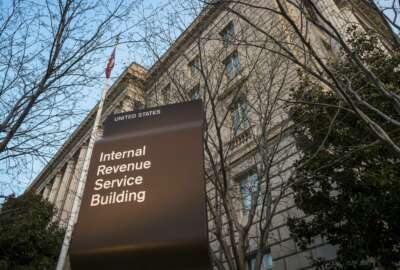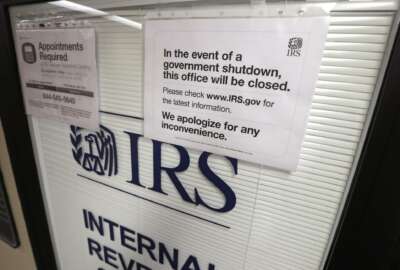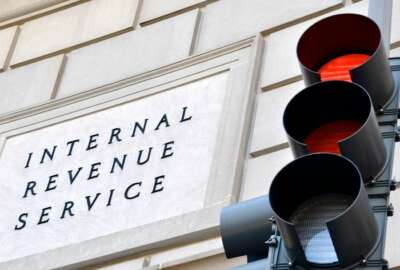

While President Joe Biden has proposed increased IRS spending by $80 billion over the next 10 years, the long-term nature of workforce planning and IT modernization...
Best listening experience is on Chrome, Firefox or Safari. Subscribe to Federal Drive’s daily audio interviews on Apple Podcasts or PodcastOne.
The IRS is gearing up for a “significant hiring” of employees who are looking to join the agency at all stages of careers, as well as bringing back former IRS employees to tackle a growing workload.
IRS Commissioner Chuck Rettig said the Biden administration’s full budget request it will unveil next week includes increased funding for operations support, which includes IT funding.
The administration, in a Treasury Department report Thursday, proposed increased the IRS workforce by a maximum of 15% each year for the next 10 years, with a focus on hiring enforcement and taxpayer service personnel. The agency, under this plan, would also see its budget increase by about 10% year over year.
“This is a sizable increase, but a necessary one given that the IRS’s responsibilities have grown dramatically over the intervening period,” the Treasury report states.
The hiring push, however, is also meant to get ahead of the 52,000 IRS employees expected to retire or leave the agency over the next six years. The agency has a workforce of about 83,000 employees.
Chuck Rettig told the Senate Appropriations Committee’s Subcommittee on Financial Service and General Government those attrition numbers are the “real figure” the agency expects, taking into account that the average IRS employee keeps working five years after they’re retirement eligible.
National Treasury Employees Union President Tony Reardon said the union will urge Congress to adopt the administration’s plan for the IRS “giving the civil servants who work there the tools they need to do the job.”
“Treasury’s plan is a full 180-degree turn away from 10 years of budget cuts that slashed the IRS workforce and starved the agency of the resources it needs to function as intended,” Reardon said.
National Taxpayer Advocate Erin Collins said the IRS faces challenges getting qualified candidates onboard because of a lengthy competitive hiring process that’s common among federal agencies.
“The IRS hiring process is a little slow, and as a result, I think we lose good talent because if the process takes three-to-six months before we make a commitment and we make you an offer, you probably have had four or five offers somewhere else,” Collins said.
NTEU’s labor agreement with IRS gives management the right to post job vacancies internally and outside the agency at the same time. The selecting official gets both lists of internal and external candidates at the same time.
Reardon said the labor contract requires internal candidates are reviewed and considered first, but if none are selected, the agency can immediately review and consider the candidates on the external list. There is no wait time before the external hiring process can be initiated.
But Collins said filling senior positions, in some cases, can be a lengthy process.
“We may have a position at a mid-level leadership that we fill from within. So we advertise, we interview, we get the position filled, but it’s within. We advertise that position, somebody within applies. So great, we’re promoting someone’s career. You go all the way down, we’ve hired six people but only one new person. That’s what happens, and I could now have 12 months go by before I got that one new person,” she said.
Reardon said the IRS could quicken the pace of hiring by focusing resources on rebuilding its Human Capital Office.
“It simply doesn’t have the staffing and resources in place to have an efficient hiring process, as was noted by Commissioner Rettig in recent testimony to Congress,” Reardon said.
While President Joe Biden has proposed increased IRS spending by $80 billion over the next 10 years, the long-term nature of workforce planning and IT modernization requires a commitment to steady funding increases.
Former IRS Commissioner Charles Rossotti said the IRS could reasonably shrink the tax gap between what taxpayers owe and what the agency collects by $1.4 trillion over 10 years, if Congress granted 6% increases to its budget over the same period.
“If you tried to give them a huge amount for two years and then say, ‘OK, now tell me what happened,’ frankly it wouldn’t work,” Rossotti said
With the right training and upskilling of its workforce, Rettig said the IRS could effectively shrink the tax gap by 10-20%, which would translate into $700 billion, according to Treasury estimates. Part of the funding would restore in-person training for IRS, which he said has been discontinued for years.
“It would be a game-changer for the country in terms of what the IRS would be able to bring from amounts lawfully owed to the government,” Rettig said.
Estimates of the annual tax gap range from $500 billion to $1 trillion. Rossotti estimated the tax gap last year at $574 billion, a sum equal to what the IRS collected from the bottom 90% of taxpayers.
“This is commonly called the tax gap, but that gap is really a gorge,” Subcommittee Chairman Chris Van Hollen (D-Md.) said.
Congressional Republicans, however, remain deeply skeptical of giving the IRS more money beyond the $3 billion in supplemental funding it has received during the COVID-19 pandemic. About $2 billion of that funding Congress focused on IT spending at the IRS.
Subcommittee Ranking Member Cindy Hyde-Smith (R-Miss.) said the IRS has pulled $1 billion away from its enforcement operations to fund its IT since 2013. The agency, she added, expects to divert another $200 million from enforcement to support IT spending later this year.
“Congress originally designated these funds to beef up the IRS enforcement ranks. Unfortunately, we have seen the IRS repeatedly call attention to the tax gap and then divert the funds somewhere else,” Hyde-Smith said.
The IRS launched a six-year IT modernization plan in 2019, but only received 55% of the funding it requested from Congress. In order to keep modernization on schedule, Rettig said IRS has had to pull resources from every part of the service, and yet the IT modernization plan is still not on schedule.
The IRS has also had to buy laptops and other equipment through its operations support budget. Those costs increased significantly during mandatory telework.
The IT modernization effort would improve taxpayer services, enforcement and would reduce the costs to maintain its legacy IT systems. Rettig said IRS is running a $1.3 billion annual deficit on operations support to maintain its systems.
“We need to modernize in order to level that curve, if you will,” he said.
Despite these challenges, Rettig said the IRS has had “considerable” success with its IT modernization.
“We are not where we would want to be, but we’ve made huge strides in that area,” he said.
Copyright © 2025 Federal News Network. All rights reserved. This website is not intended for users located within the European Economic Area.
Jory Heckman is a reporter at Federal News Network covering U.S. Postal Service, IRS, big data and technology issues.
Follow @jheckmanWFED



